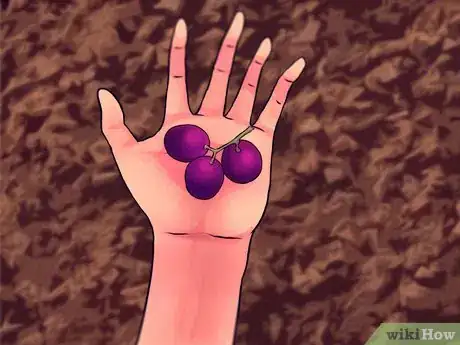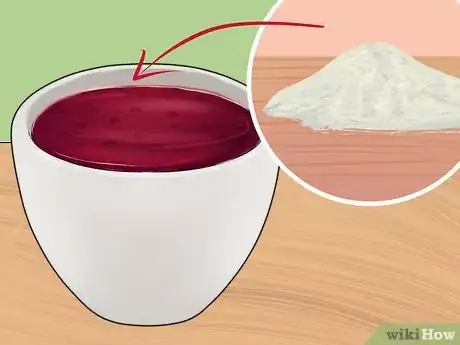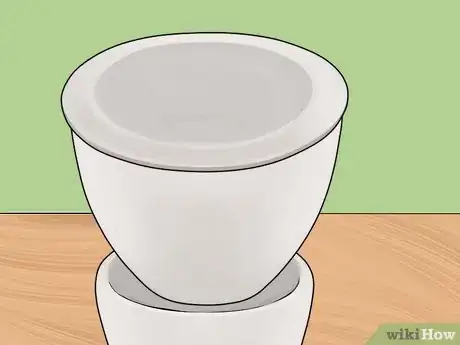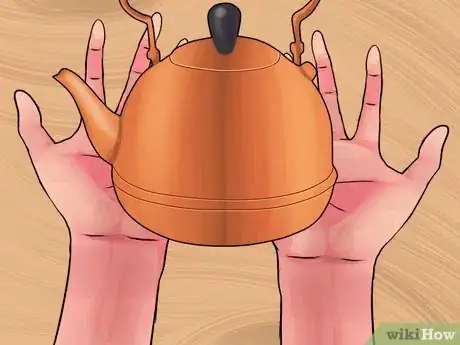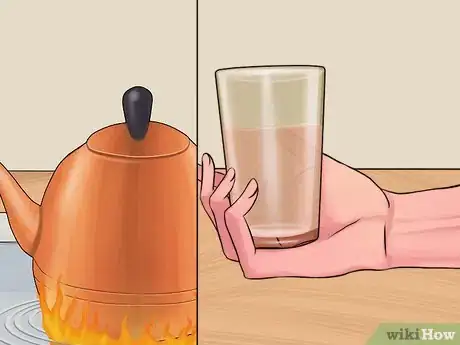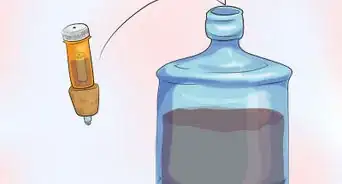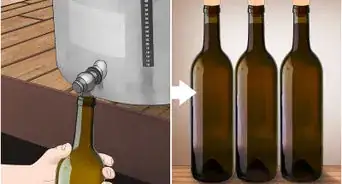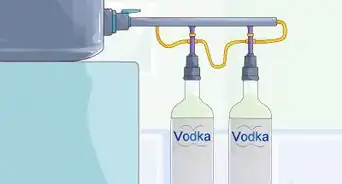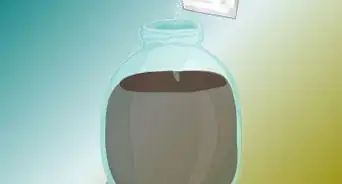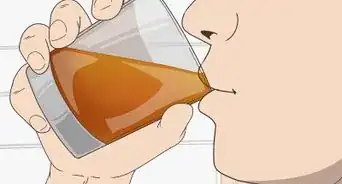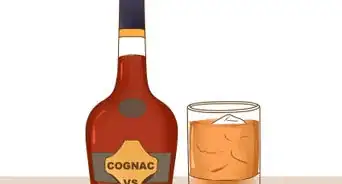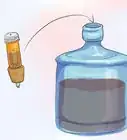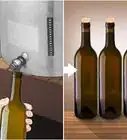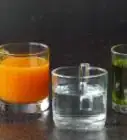wikiHow is a “wiki,” similar to Wikipedia, which means that many of our articles are co-written by multiple authors. To create this article, 29 people, some anonymous, worked to edit and improve it over time.
There are 8 references cited in this article, which can be found at the bottom of the page.
This article has been viewed 783,674 times.
Learn more...
Making homemade brandy is the perfect way to warm yourself with the flavors and scents of summer all year long. Brandy is created by distilling wine, which can be made at home using any type of fruit. After the fruit has fermented, the liquid is distilled twice to produce a strong, clear spirit with the essence of peaches, plums, pears, or apples. To learn how to make this delicious concoction in your own kitchen, read ahead.
Steps
Making the Wine
-
1Choose the fruit you want to use. Traditionally, making brandy at home was a way to capture and preserve the flavors and fragrances of summer and fall fruits. Pears, apples, grapes, peaches or plums were gathered, processed into wine, then distilled into fruit brandies. If you want to make your own wine, you'll need to gather your fruit and start the fermentation process at least a month before you distill it to make brandy. If you'd prefer to start distilling right away, purchase a few liters of fruit wine and skip to the next section.
- Wait until the fruit you want to use is in season, and harvest at the peak of ripeness.
- For this recipe, you'll need about 3 quarts of fruit, which will yield enough wine to make a small batch of brandy. Harvest and ferment more fruit if you want more brandy.
- Commercial brandy is usually made from grape juice or crushed grape skins. The resulting distillate is harsh in taste, so it's aged in oak barrels to take off the edge. Brandy made from fruit other than grapes is more suited to making at home, since it doesn't require oak barrel aging.
-
2Process the fruit. Wash it thoroughly, then cut it into slices. There's no need to peel the fruit, but you should remove pits for this recipe.Advertisement
-
3Mash the fruit in a stone crock or glass jar. Place the fruit in the jar, then use a potato masher or another instrument to mash it down. This will help the fermentation process go more quickly.[1]
- If you're using berries, which are lower in sugar than other types of fruit, you'll need to add sugar. Line the bottom of the crock with sugar, then add a layer of fruit. Add more sugar, and continue layering until the fruit and sugar have been used up.
- Use a stone crock large enough to accommodate all of the fruit with a few inches to spare, since the mixture will bubble up during the fermenting process. If you don't have a stone crock, you can use a glass bowl or another thick, heavy container. It should be made of glass or ceramic, not wood or metal.
-
4Add yeast and water. Dissolve 6 teaspoons of dry yeast in a cup of warm water. Use active dry yeast, not instant yeast, found at any grocery store. Pour the yeast mixture over the fruit and sugar mixture.[2] Add six cups of cold water.
-
5Place the crock on a tray and cover with a plate. The liquid inside will begin to bubble up during the fermenting process, so you'll need the tray to catch any overflow. Leave the mixture in a cool place for a week.
-
6Stir the mixture once a week for four weeks. Uncover the crock and use a clean, long-handled spoon to stir it thoroughly, then place the cover on top. Each week the alcohol content will increase.
-
7Bottle the wine. At the end of four weeks, pour the wine into glass bottles and cover tightly. You can store the wine for several months to deepen the flavor.[3]
Gathering Supplies and Assembling Your Still
-
1Obtain a still. To make brandy at home, you'll need a still small enough to operate on your stovetop. A 1 1⁄2 to 2 liter (0.4 to 0.5 US gal) alembic copper still will probably be sufficient for your needs.[4] To find a still, look in local kitchen supplies stores, online, and in secondhand stores. You'll be able to use it to make other spirits in addition to endless batches of brandy.
- If you purchase a new or secondhand still, be sure to clean it before using.
- If you want to experiment with a very small batch of brandy, you can construct a still with a copper tea kettle and plastic tubing.
- If you find that you enjoy making brandy so much that you'd like to make larger batches, you can upgrade to a 5 gallon (18.9 L) still. Anything larger than this will be too big for home brandy-making.
-
2Ready your other supplies. In addition to your base wine and still, you'll need an array of clean glasses, a ladle, and other supplies to complete the distillation process. Gather the following materials and set them out in a clean workspace within easy reach of the stove:
- A Dutch oven or another pot large enough to fit the still inside. This will be filled with water and used as a double boiler of sorts to give you maximum control over the heating of the still.
- Plenty of glass containers. As the still does its work, you'll need small, clean glass containers to hold what comes out of the pipe.
- A graduated cup will come in handy if you want to measure exactly how much you have.
- A sealable large glass jar, for storing the finished brandy.
- A towel, for wiping up any spills that might occur.
-
3Situate the still on your heat source. First, fill the Dutch oven with a few inches of water. Put the still inside. Add more water if necessary; it should rise about three-quarters of the way up the sides of the still. Set the Dutch oven and still over a gas burner or whatever heat source you're using.
- If you're using a large 5 gallon (18.9 L) still, it won't fit inside a Dutch oven, so you'll need to skip this and place the still directly over your heat source.
-
4Fill the still 3/4 full with your wine. No matter what size still you're using, leave the top 1/4 of the still empty. When the wine heats up, it can bubble and rise, so it's important not to fill the still all the way.
-
5Put the still together. Place the lid on the still, then connect the tube from the lid to the condenser coil. Place cold water in the condenser and set a glass under the spout to collect the alcohol that flows from it. Different still models will require slightly different assembly, so read the instructions that came with your still carefully. It's vital that you follow the directions that came with the still you have to ensure the distillation process runs smoothly.
Distilling the Wine
-
1Heat the distilling pot. When making brandy, you never want to let the contents of the still get too hot; the distillation process should be slow and steady. The wine should come to a good simmer, but not a boil. Start heating the still with a strong flame, and keep it strong until alcohol beings to drip from the spout. If the alcohol begins dripping too quickly, you'll need to turn down the heat. Do not let the alcohol drip faster than 1 drop per second.[5]
- You'll know the alcohol is going to start flowing soon by touching the copper tube where it enters the water. When it becomes hot, the alcohol is about to flow.[6]
- The slower the liquid flows from the spout, the better quality your brandy will be.
-
2Collect the foreshots. The first distillate that comes from the still, about 7.5 ml per 1.5 liters (0.4 US gal) of wine, is called the foreshots, and it contains a toxic combination of acetone and methyl alcohol. Measure out the emerging foreshots or take a whiff; when the strong, sharp smell of chemicals abates, it's done flowing. The foreshots should be thrown away; there's nothing drinkable there.
-
3Collect the heads.[7] The next liquid to emerge will be the heads, which is a combination of acetone, methyl alcohol, methanol, and ethyl acetate.[8] If you're planning to make a second batch of brandy sometime soon, it might be worth saving the heads, which may be distilled a second time to preserve the "good" ingredients and remove the "bad." It's also fine to simply throw the heads away.
- Collect the heads in small glasses. You'll want to be able to save every drop of the hearts - the good stuff - which is coming out next. Collecting the distillate in a big glass increases the chances that everything will get muddled together.
- Keep smelling the distillate as it flows. The heads will smell better than the foreshots, but not nearly so sweet and pure as the hearts.
- The heads and foreshots together will comprise the first 30 ml per 1.5 liters (0.4 US gal) of wine.
-
4Collect the hearts.[9] When the hearts start to come, the smell of the distillate will have hints of the fruit you used to make your wine. You'll smell pear, peach, plum or apple essence without the harshness of acetone. The distillate should be clear, not milky. Continue collecting it in small glasses, monitoring the smell for changes.
- Adjust the temperature as necessary. As the distillation process nears its end, you'll need to keep increasing the temperature to achieve the same flow rate. Keep turning it up so that 1 drop per 1-3 seconds continues to flow.
- Do not overheat the still, and do not let it boil dry.
-
5Watch for the tails.[10] The last distillate to exit will be the tails, which is less concentrated and less tasty. You'll notice a change in smell; the fruitiness will be gone. It may also look milky. This should be discarded. When the tails come, turn off the heat.
- After the distillation process, it's important to clean your still carefully.
Finishing the Brandy
-
1Pour the hearts into a large glass jar. You should have 300 mL of drinkable brandy for every 1.5 liters (0.4 US gal) of wine you distilled. Store the brandy in the jar with a tight lid.
-
2Smell and taste the brandy.[11] If you smell strong hints of acetone and methyl alcohol in your finished brandy, you can store the jar with a piece of cloth rubber banded over the top to let it breathe for a few days. The unpleasant smell and taste will leave the brandy as the acetone and methyl alcohol evaporate.
-
3Age the brandy. If you're not in a hurry to drink your brandy, you can mellow it out a bit by waiting a few months before drinking. Screw the lid on tightly and store it in a cool place for several months. When you open the brandy, it should have a smoother taste than it did when you first distilled it.
-
4Consider re-distilling your brandy. It's not commonly done at home, but you can distill the brandy a second time to increase the alcohol content and refine the flavor. However, since doing this makes the distillate very flammable, it's not advisable to do so until you have plenty of experience operating your still.[12]
Community Q&A
-
QuestionCan I use a stainless steel still to make the brandy or does it need to be copper?
 Community AnswerYes. Some people say that brandy made in copper tastes better, but most people can't tell whether it is made in a copper or stainless steel still.
Community AnswerYes. Some people say that brandy made in copper tastes better, but most people can't tell whether it is made in a copper or stainless steel still. -
QuestionThe brandy that I made from grape wine is colorless, but the brandy I bought from store has color. Why?
 Community AnswerAging in wood barrels or adding wood spirals and/or honeycombs to the distillate flavors and colors the final product.
Community AnswerAging in wood barrels or adding wood spirals and/or honeycombs to the distillate flavors and colors the final product. -
QuestionWhere can I buy the equipment I need?
 Community AnswerYou should be able to get everything you need from eBay.
Community AnswerYou should be able to get everything you need from eBay.
Things You'll Need
For the Wine
- Fruit
- Water
- Yeast
- Crock or glass jar
For the Brandy
- Wine
- Copper still
- Dutch oven
- Small glasses
- Graduated cup or cylinder that measures in milliliters
Warning
- Making brandy at home with a still is technically illegal in the US.[13]
References
- ↑ http://dish.allrecipes.com/how-to-make-wine-at-home/
- ↑ http://dish.allrecipes.com/how-to-make-wine-at-home/
- ↑ https://www.homebrewing.org/How-To-Make-Wine-at-Home_ep_87-1.html
- ↑ https://www.motherearthnews.com/diy/home/home-distilling-zw0z1212zmat
- ↑ https://www.motherearthnews.com/diy/home/home-distilling-zw0z1212zmat
- ↑ https://www.motherearthnews.com/diy/home/home-distilling-zw0z1212zmat
- ↑ https://www.diffordsguide.com/encyclopedia/198/bws/distillation-the-science-of-distillation
- ↑ https://sciencing.com/test-alcohol-methanol-8714279.html
- ↑ https://www.diffordsguide.com/encyclopedia/198/bws/distillation-the-science-of-distillation
About This Article
To make homemade brandy, start by making wine with fruit like pears, apples, peaches, or plums. Once you've made your wine, pour it into a small, stovetop still. Heat the still over a burner and collect the alcohol that flows out of the spout. Once you've collected all of the alcohol, pour it into a large jar with a tight lid. If you want your brandy to have a smoother taste, let it mellow for a few months before you drink it. To learn how to make wine with fruit and distill the wine to get your brandy, keep reading!
